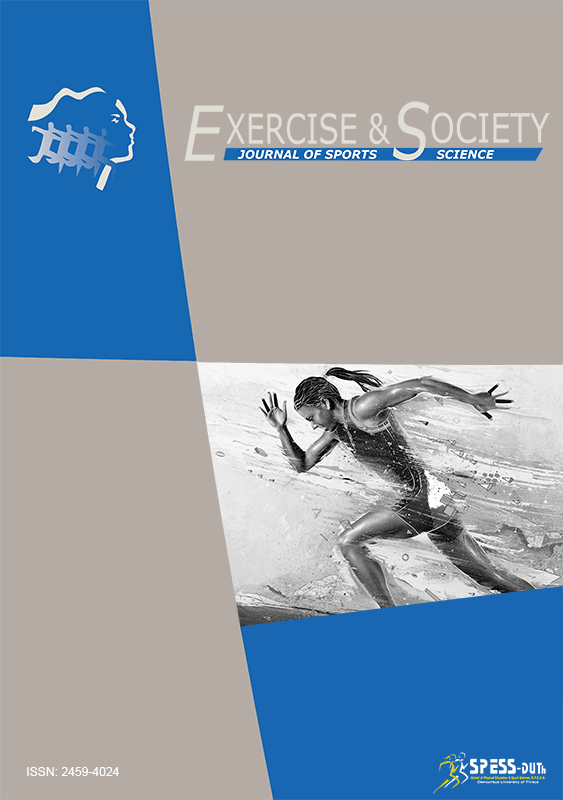Development and examination of an assessment tool of effective teaching in physical education
Abstract
The purpose of this study was to develop and examine an evaluation tool of effective teaching of physical education teachers. An observation protocol with six thematic units and 25 criteria was created, with which 22 elementary school teachers from the prefectures of Pella, Imathia, and Thessaloniki were evaluated (14 men and 8 women). Specifically, their teaching in 2nd and 5th grade was observed, and a total of 88 lessons (44 for each grade) were videotaped. Descriptive statistics, chi-square (x2) test and independent measures t-test were used for data analysis. Also, the internal consistency of the protocol was examined by calculating the coefficient alpha of Cronbach. The results showed that the protocol is a valid and reliable tool, as it distinguished the teaching practice of the teachers in the six thematic units for both grades. It can be concluded that the observation protocol can be used for the evaluation of the teachers since its six thematic units capture the core of the theoretical structure of effective teaching in physical education.References
Ball, D. L., Sleep, L., Boerst, T. A., & Bass, H. (2009). Combining the development of practice and the practice of development in teacher education. The elementary School Journal, 109, 458-474.
Blank, R. K. (2002). Using surveys of enacted curriculum to advance evaluation of instruction in relation to standards. Peabody Journal of Education, 77(4), 86-121.
Byra, M. (1992). Measuring Qualitative Aspects of Teaching in Physical Education. Journal of Physical Education Recreation and Dance, 63(3), 83-89.
Cheffers, J., Mancini, V., & Martinek, T. (1980). Interaction analysis: An application to nonverbal activity. St. Paul, MN: Amidon.
Chen, W., Burry-Stock, G., & Rovegno, I. (2000). Self-evaluation of expertise in teaching elementary physical education from constructivist perspectives. Journal of Personnel Evaluation in Education, 14(1), 25-45.
Chen, W. (2009). Confirmatory factor analysis of achieving the beginning teacher standards inventory. Educational Research and Evaluation: An International Journal on Theory and Practice, 15(3), 285-304.
Chen, W., Hendricks, K., & Archibald, K. (2011). Assessing pre-service teachers' quality teaching practices. Educational Research and Evaluation, 17(1), 13-32.
Danielson Group. (2013). The Framework for Teaching Evaluation Instrument (FFT). Princeton, NJ: Author.
Δέρρη, Β. (2007). Η Φυσική αγωγή στην αρχή του 21ου Αιώνα. σκοποί, στόχοι, επιδιώξεις στην Πρωτοβάθμια εκπαίδευση. Θεσσαλονίκη: Εκδόσεις Χριστοδουλίδη.
Farr, S. (2010). Teaching as Leadership: The highly effective teacher's guide to closing the achievement gap. New York: John Wiley and Sons.
Grossman, P., & McDonald, M. (2008). Back to the future: Directions for research in teaching and teacher education. American Educational Research Journal, 45, 184-205.
Kyrgiridis, P., Derri, V., Emmanouilidou, K., Chlapoutaki, E., &Kioumourtzoglou, E. (2014). Development of a Questionnaire for Self-Evaluation of Teacher Effectiveness in Physical Education (SETEQ-PE). Measurement in Physical Education and Exercise Science, 18(2), 73-90.
Lund, J. L., & Kirk, M. F. (2002). Performance-based assessment for middle and high school physical education. Champaign, IL: Human Kinetics.
Mathers, C., Oliva, M., & Laine, S. (2008). Improving instruction through effective teacher evaluation: Options for states and districts, Washington, DC:
National Comprehensive Center for Teacher Quality. Retrieved fromhttp://www.tqsource.org/publications/February 2008 Brief.pdf
McCombs, B. (1997). Self-assessment and reflection: Tools for promoting teacher changes toward learner-centered practices. NASSP Bulletin, 81, 1-14.
Moskal, B. M. & Leydens, J. A. (2000). Scoring rubric development: validity and reliability. Practical Assessment, Research & Evaluation, 7(10). Ημερομηνία ανάκτησης: 4-11-2009. http://PAREonline.net/getvn.asp?v=7&n=10
Mujis, D. (2006). Measuring teacher effectiveness: Some methodological reflections. Educational Research and Education, 12(1), 53-74.
National Association for Sport and Physical Education (NASPE) (2003). National standards for beginning physical education teachers (2nd ed.). Reston, VA: Author.
National Association for Sport and Physical Education (NASPE) (2004). Moving into the future: National standards for physical education (2nd ed.). Reston, VA: Author.
National Association for Sport and Physical Education (NASPE) (2007). Physical Education Teacher Evaluation Tool [Guidance document]. Reston: VA: Author.
National Council on Teacher Quality [NCTQ]. (2012). CTQ State Teacher Policy Yearbook Brief Area 3: Identifying effective teachers. Ημερομηνία ανάκτησης: 11-2-2013. http://www.nctq.org/reports.do?d=state+Policy&searchTerm=Identifying+Effective+Teachers
Parker, M. (1989). Academic Learning Time-Physical Education (ALT-PE), 1982 Revision. In P. W. Darst, D. B. Zakrajsek & V. H. Mancini (Eds.), Analyzing Physical Education and Sport Instruction, 195-205. Champaign, IL: Human Kinetics.
Rink, J., & Werner, P. (1989). Qualititative Measures of Teaching Performance Scale. In P. Dart, D. Zakrajsek, & P. Mancini (Eds.), Analyzing physical and sport instruction (2nd ed.), 296-276. Champaign, IL: Human Kinetics.
Shulman, L. S. (2004). The wisdom of practice: Essays on teaching, learning, and learning to teach. San Francisco, CA: Jossey-Bass.
Siedentop, D. (2002). Ecological perspectives in teaching research. Journal of Teaching in Physical Education, 21, 427-440.
Van der Mars, H. (1989). Observer reliability: Issues and procedures. In P. W. Darst, D. B. Zakrajsek, & V. H. Mancini (Eds.), Analyzing physical education and sport instruction (2nd ed.), 53-80. Champaign, IL: Human Kinetics.
Υπουργείο Εθνικής Παιδείας & Θρησκευμάτων (ΥΠΕΠΘ) (2007). Φυσική Αγωγή στο Δημοτικό. Βιβλίο Εκπαιδευτικού. Αθήνα: ΟΕΔΒ.
Υπουργείο Παιδείας Δια βίου Μάθησης και θρησκευμάτων (2011). Από το Σήμερα στο Νέο Σχολείο με Πρώτα τον Μαθητή. Ημερομηνία ανάκτησης: 21-8-2012. http://www.minedu.gov.gr/apo-to-simera-sto-neo-sxoleio-me-prota-ton-mathiti.html
Υπουργείο Παιδείας & Θρησκευμάτων (2013). Π.Δ. 152/2013 (ΦΕΚ Α 240/05-11-2013).
Downloads
Published
How to Cite
Issue
Section
License
Authors who publish with this journal agree to the following terms:
a. Authors retain copyright and grant the journal right of first publication with the work simultaneously licensed under a Creative Commons Attribution License that allows others to share the work with an acknowledgement of the work's authorship and initial publication in this journal.
b. Authors are able to enter into separate, additional contractual arrangements for the non-exclusive distribution of the journal's published version of the work (e.g., post it to an institutional repository or publish it in a book), with an acknowledgement of its initial publication in this journal.
c. Authors are permitted and encouraged to post their work online (e.g., in institutional repositories or on their website) prior to and during the submission process, as it can lead to productive exchanges, as well as earlier and greater citation of published work (See The Effect of Open Access).


